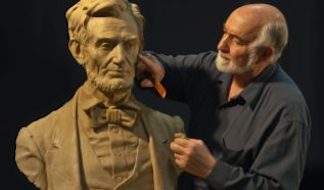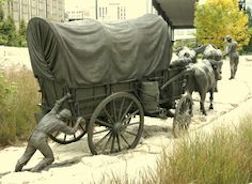Edward J. Fraughton
Edward J. Fraughton is an American artist, sculptor, and inventor. He earned a Bachelor of Fine Arts degree from the University of Utah with a sculpturing major. He initially pursued a degree in civil engineering. He did post-graduate work under Avard Fairbanks.
In the years following his graduation, he worked in sales, substituted in high school, drove a delivery truck, and was a foundry worker in a bronze casting facility. In 1966, Fraughton was hired by Thiokol Chemical Corporation to use his artistic training at the newly created Job Corps Center in Clearfield, Utah. “Managed by the Office of Economic Opportunity (OEO), Job Corps was an initiative launched by the Lyndon B. Johnson Administration to fight the "War on Poverty.” After the first year of operations, on August 22, 1967, Fraughton received a letter from W. C. Hearnton, Assistant Director of Avocational Training, stating in part:
- ”For nearly three months after reporting for work here at Clearfield, he (referring to Fraughton) was the only member of the Arts and Crafts Department. During this three-month period, he wrote and secured OEO approval for the curriculum that we are now offering to our Corpsmen population.
- ”Out of the one hundred and fifty (150) Job Corps Centers located throughout the United States, our program is viewed by OEO as the best in existence. In no small measure, the success of our program can be attributed to the professional competence and know-how of Mr. Fraughton.”[1]
He left Job Corps in 1967 to sculpt full time. His first commission was creating a series of historical portraits for The Church of Jesus Christ of Latter-day Saints, of which he is a member. He has created busts of early Church leaders for visitors' centers and the Mormon Battalion Monument in San Diego.
- But his work extends far beyond the Latter-day Saint community. His bust of John F. Kennedy is in the Kennedy Memorial Library in Boston. He has won four gold medals from the National Academy of Western Art (N.A.W.A.) and has had his work exhibited at the White House. The public television film series “Profiles in American Art” has featured his life and art. And his spirited optimism has created a heroic-sized bronze monument of a bucking horse and rider that stands in front of the Wyoming State Capitol. According to Ed Muno, art director of the N.A.W.A., “Ed Fraughton is clearly one of the best sculptors working today.”[2]
In 1973 Fraughton was awarded his first gold medal at the National Academy of Western Art for his sculpture entitled, "Where Trails End." Awards from the National Sculpture Society, National Academy of Design and other prestigious art organizations soon followed. In 1980, Fraughton was selected to create the inaugural medal for President Ronald Reagan. During Reagan’s eight years in office, a copy of "Where Trails End" was exhibited in his private office in the White House. The same piece is now on permanent display at the Reagan Presidential Library in Simi Valley, California.
Some of Fraughton’s more recent works includes “Nebraska Wilderness” and “Pioneer Courage,” created with sculptors Blair Buswell and Kent Ullberg. The ten-year collaboration was commissioned by the First National Bank of Omaha and depicts an historic pioneer wagon train moving west through Nebraska's wilderness during the mid-19th century.
- “Encountering a herd of wild American bison, the animals quickly turn and run through the city streets toward the Bank's new 40-story office building. As the buffalo approach an elevated pond and fountain facing the building's front entrance, a flock of Canada geese explode from the water, fly around the surrounding air space and through the windows of a glassed-in atrium housing the building's historic facade. The geese slowly morph from traditional bronze into modern polished stainless steel as they enter the building. The artistic effect and integration of all elements create a unique and startling effect in the world of contemporary realist sculpture. This project is the largest single installation of monumental sculpture in North America, the linear space covering an area of approximately five city blocks.”[3]
Another monument stands at the Visitor's Center and Museum entrance into Mesa Verde National monument near Cortez, Colorado. The twenty-foot high monument depicts an ancient ancestral rock-climbing Puebloan Indian descending a sheer narrow column of sandstone with a basket of corn, symbolic of the ancient cliff-dweller culture of the American Southwest.
Fraughton developed an improved method for enlarging his sculpture into monumental scale using digital imaging and CNC cutting. “His technique allows positive clay components to be produced to any scale with greater integrity, thus improving efficiency during the direct modeling stage.”[4]
Following a mid-air collision over the Salt Lake Valley in 1987 that destroyed two airplanes and claimed ten lives, Fraughton, who is also a pilot, invented and patented a new technology for tracking aircraft. This technology, which he patented in 1992, is popularly known as ADS-B. It uses GPS satellite tracking to find and report aircraft positions. He went on to serve on several committees associated with the Federal Aviation Administration (FAA), most notably the original ADS committee and Special Committee 186 of the Radio Technical Commission for Aeronautics.


